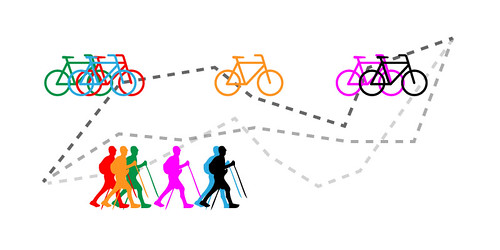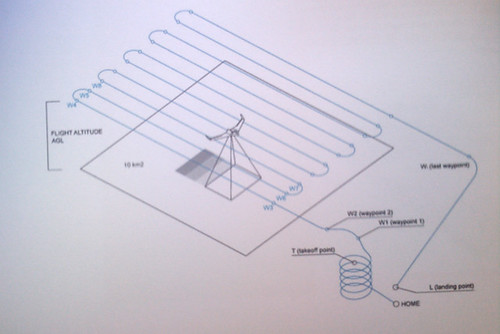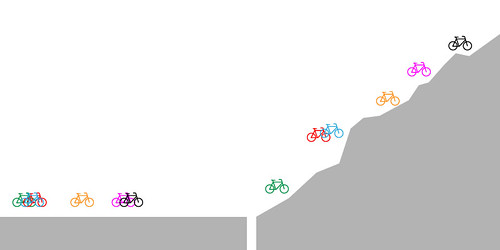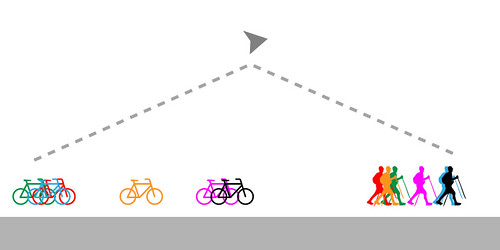Resilient Travel - from Biking to Hiking
2012-08-28 11:58:04 by Theun Karelse
This summer the Resilients have been exploring the European continent in various ways in various areas. Some of these expeditions have been undertaken by groups; the Peregrini / Pollinator bikers through Central Europe and the Unmanned Resilience hikers through Slovenia. What can be learned by overlaying the two experiences? I propose the use of UAV-mission-planning vocabulary for this analysis and for designing future resilient modes of travel.
- Take-off-Point: after preparations (coffee) the mission starts from this point
- Rally-Point: final destination to reassemble the group and decide on base camp
- Loiter: (waiting)point to reassemble the group for required navigation or food
- Waypoint: points used for navigation along the trail
- Fail-Safe: general ways of resolving unexpected events or failures. If… fails, do…
Generally comparing biking and hiking: The strain on the body, the amount of food and supplies needed were quite similar for both journeys. The experience of the landscape is somewhat more intimate on foot, but more can be explored on bike. Basically you always have sore legs, but on the bike your ass hurts too. Depending on the area cyclists are more flexible in finding food sources, supplies and shelter due to their wider radius of operation. Also heat is less of a factor for cyclists.
Preparation: Try and stay lightweight. As a participant in both expeditions generally the preparations were very similar; bring essential clothing only, but for a range of weather conditions, very basic utensils (cup, knife, spoon,ear-plugs,sun-cream), tent and sleeping gear. Obviously shoes are less important on bikes, but cyclists need some tools for repairs.
Navigation: During both missions navigation played a very prominent role. A daily mission would be planned setting a take-off-point and often several options for rally-points and loiters (for lunches, swimming, final destination, etc). In both cases setting a daily route would fall back to only a couple of individuals in the group. This turns out in both cases to greatly impact group-resilience. (See Fail-Safes below.) For the Peregrini bikers a trail had to be planned along the fold using place-names as crude waypoints. The Slovenian hikers would follow existing marked paths as waypoints, which were much more frequent which greatly reduces errors. Group travel includes many instances of loitering, more so for the cyclists, because at many cross-roads the group needed re-navigating and because of the many available places for taking food supplies (village-shops). For the hiking group loitering only occurred at points where existing markings failed of for taking food supplies (Dario's wild food finds).
Group structure: It's quite clear that traveling as a single group is easier on foot than on cycles where differences in speed are increased by the introduction of gears. Traveling in mountainous terrain these differences become expressed even more, both on foot and bike. This can reduce the resilience of the group when some travelers fall behind; those who struggle can be found in the back. In case of any additional misfortune this can result in a lack of support.
Fail-Safes:
Carrying capacity: In the case of the cycling group along the fold everything was carried by the travelers and only redistribution of materials was an option. For group on foot a jeep was in place as a fail-safe which could carry some equipment.
Navigation: The hikers relied on a marked trail and familiarity with the area, but the cyclists relied on GPS-apps, maps, place names and mobile phones as fail-safes for navigation errors. The level of failure was a prominent frustration to the process of reaching the rally-points along the fold.
Accidents and break-downs: In both groups keeping track of those traveling at the back of the group was an issue. Unfortunately accidents have happened where little back-up was available and mobile-phone connections failed. From the tough lessons learned along the fold by the cyclists, the hikers in Slovenia integrated a fail-safe by keeping a small group at the end, especially when a traveller was struggling or even ill. Also the jeep served as a back-up but due to the success of our fail-safe this wasn't needed.
For resilient travel a fail-safe system could be: detailed info for the trail including editable take-off-point, way-points, loiters and rally-points distributed by an independent mode of communication (mesh-network) accessible to all group members, perhaps even enabled by a convoi-ing UAV.




